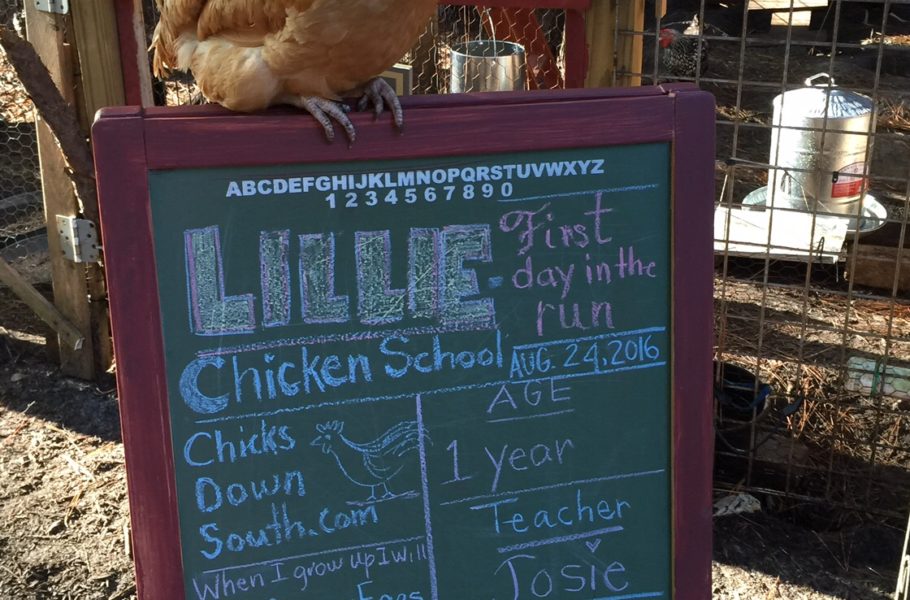
`Chickens Go To School Too So It’s Up To Mama to Make Things A Go
Chickens Go To School Too So It’s Up To Mama to Make Things A Go
Rehoming, new chickens and more!
It’s back to school for kids and as a public school teacher of over 36 years, I know about the “pecking order” even in a classroom of students and even among school leadership. There is a sort of pecking order being established at the beginning of every school year. In every group there is a period of setting up the order of the community and it occurs at all levels; school committee members, parent relational meets, student and classroom establishments and in a simple or complex chicken yard. The pecking order is real and every chicken yard has had girls within it’s wire vying for top chicken. When new animals are introduced to a new run, the entire chicken group is affected.
The term pecking order comes from the dominance settling of a flock of chickens or birds. In any flock, there is an order to be established and it occurs among chickens finding their places among the group. And, yes, it is most often seen first with pecking. A dominant hen will peck at other hens in the run establishing a strong presence. It that chicken runs away or retreats the order of power begins. It is true also that sickly or small birds are often the focus of the bullies or those of a dominant nature so it is imperative for flock owners to be mindful in watching carefully as birds are put together.
Stress
Rehoming, adding or replacing chickens in a run is a very stressful event no matter the case. There is a definite pecking order and sequence of dominance or subservience in every chicken yard. Characteristics of the order-choosing events are many such as pecking, chasing, fussing, bumping breast to breast, blocking one from the water or food, sitting on one in the roosting box to name some.
There are times in the life of every chicken farmer that hens and or roosters must be moved for some reason or another. When this occurs, it shifts the lives of all in the run. Here are some helpful tips to consider when rehoming, adding or replacing chickens on a chicken farm.
1. SAFETY FIRST- Bringing any new animal onto your farm is a major undertaking so be sure that you quarantine this new chicken or rooster for a minimum of 30 days as suggested by a writer on Backyard Chickens. The purpose of this 30 day wait period is to watch for concerns in regards to behaviors and health issues. It is important that the new animal is taken to the farthest point possible for safe keeping and away from the current flock in order that the two do not mix in any way including air space if possible. These breeds should not share food, utensils or feeders. Providing this level of protection of your original stock will give the new animal time to adjust to the new surroundings and you, the farm provider opportunity to observe and become familiar. .
2. CLEANLINESS A MUST – Washing hands, clothes, shoes and other items should always be done separately. Avoid using your personal kitchen sink for washing hands or chicken eggs. Keep clothes separate from other garments. Shoes used in a chicken yard should be kept in a separate place from other shoes and footwear. Also they should be washed and rinsed on the bottoms daily or for certain weekly depending on the situation. Even healthy birds leave droppings that get on shoes and clothing. It is important to care for the health of all on the farm from humans to other animals. Being clean is paramount to a safe and happy farm.
3. AVOID MIXING NEW AND OLD ANIMALS – If you’ve been in chicken farming long, you know that it is not as simple as just mixing chickens. After the quarantine, it may be a good idea to allow chickens time to meet and greet without the possibility of pecking and deciding power attributes. One way to do this is to place the new chicken in the run with wire or cage restrictions. To introduce the new bird simply cordon off a separate section in the run or put the animal in the run inside a large crate or dog cage. This gives everyone time to meet and greet without pecking for dominance.
4. DEALING WITH CLIQUES AND CLUCKS- Hens are typical girls. They have been known to hang in cliques and often use their clucks as ways to bully other hens. Keep a look out for this.Just yesterday, I heard a definite commotion in one of the runs.The long cluck song was repetitive. I knew something was going on. Sure enough, Sylvia, an Americauna, was facing outward in a nesting box and had Goldie ( a fellow Americana) pinned in the back corner of the box. Both had already laid eggs so this was not one of those “I want to lay my egg in the same box” problems. Sylvia was surely bullying Goldie. Everyone was safe so I did not intervene. Had I seen the slightest blood or serious aggression, I would have taken action of some kind.
5. NOW INTRODUCING _________– There are various ways to introduce new chickens into the run:
a. Just put her in the new run while there is great activity. The biggest activity of the day is in morning when the feeders are full. During this time, it could work to put a new chicken into the run.
b. Add her in at dusk when everyone has already gotten settled in the coop. At night, hens get settled at dusk. After they take their places, it might be fine to put a new hen into the coop and allow her to filter out in the morning but as always in this event supervision would be necessary.
c. Place her in the run after a free-range party. On free-range days, all of the hens are moving about at a rapid pace seeking their own favorite insect or bug. There is a great amount of movement and everyone is all mixed up in the yard. This would be a fine time to place the new hen into the yard.
d. Put the hen into the run after a complete remodeling of the run furniture, toys, ladders and food tins. From time to time, a complete clean out of the run is needed. Often new dirt or ground covering is added and a total clearing of the run is important in order to re-organize food stations, water areas and more. This would be a fine time to add hens to the run because everything would be new to all of the girls.
There are several ways to handle this situation but the most important part of placing any new animal in with another is supervision to be sure she is safe and secure. In my early days of keeping chickens I did not know this and found Tess behind the chicken coop hiding from the others. Lesson learned!
Changing things up in a chicken yard is sort of like a chicken going to school. Mama must set the hen up for success but let her fly towards her happiness.`It’s Up To Mama to Make Things A Go
Please visit us on Facebook and Twitter and comment your thoughts about rehoming or moving chickens. #chickens
Click Below To Visit Our Store
Archives
- July 2020
- April 2020
- March 2020
- October 2019
- February 2018
- January 2018
- December 2017
- November 2017
- October 2017
- September 2017
- August 2017
- July 2017
- June 2017
- March 2017
- January 2017
- November 2016
- October 2016
- September 2016
- August 2016
- July 2016
- March 2016
- February 2016
- January 2016
- December 2015
- November 2015
- October 2015
- September 2015
- August 2015
- July 2015
- June 2015
- May 2015
- April 2015
- March 2015
- February 2015
- January 2015
- December 2014
- November 2014
Up and Coming Events
| M | T | W | T | F | S | S |
|---|---|---|---|---|---|---|
| 1 | 2 | 3 | 4 | |||
| 5 | 6 | 7 | 8 | 9 | 10 | 11 |
| 12 | 13 | 14 | 15 | 16 | 17 | 18 |
| 19 | 20 | 21 | 22 | 23 | 24 | 25 |
| 26 | 27 | 28 | 29 | 30 | 31 | |




